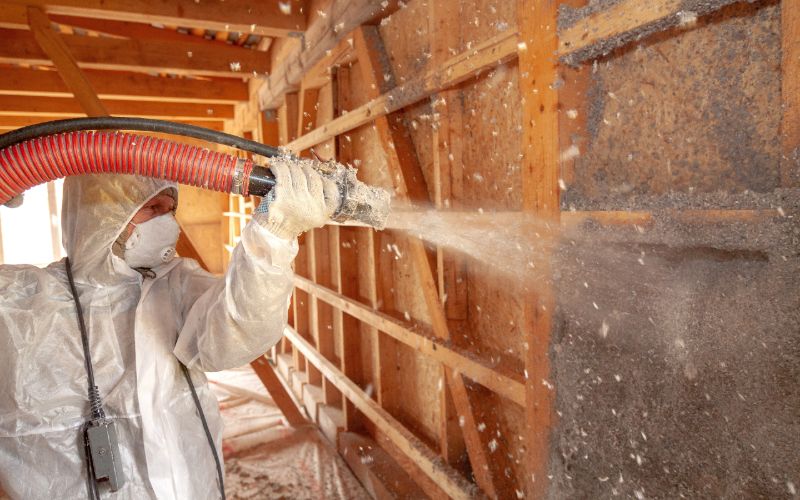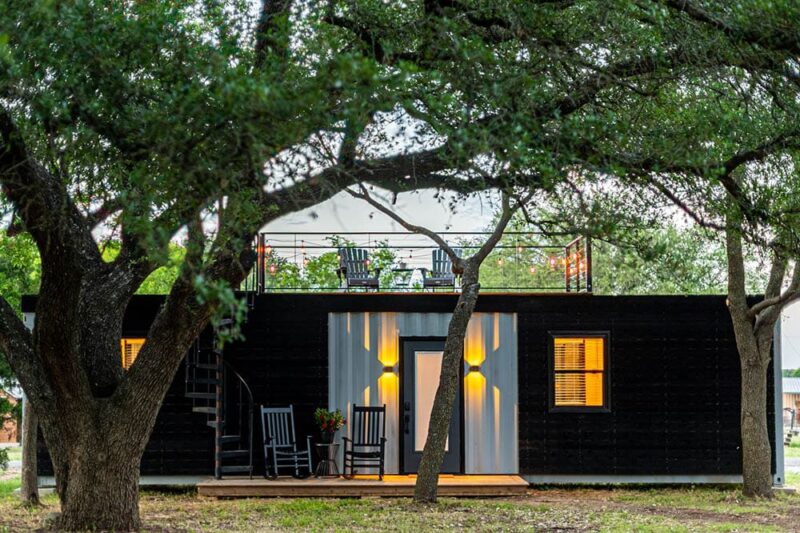5 Insulation Types for Shipping Container Homes (With Pictures)
-
Pete Ortiz
- Last updated:

Building a home from shipping containers offers an array of advantages, including cost savings and sustainability. However, it is important to consider insulation when building a container home to make it comfortable and energy efficient.
In this article, we will explore five types of insulation that are ideal for use in a shipping container home. We will discuss the benefits and drawbacks of each type to help you make the best decision for your project.
The 5 Insulation Types for Shipping Container Homes
1. Expanded Foam Insulation

| R-value | 3.6 to 8.0 |
| Type | Prefab |
| DIY-friendly? | Yes |
Expanded foam insulation is a popular choice for shipping container homes due to its affordability, ease of installation, and durability. It comes in prefabricated panels that can easily be attached to the interior walls of a shipping container.
Expanded foam has an R-value ranging from 3.6 to 8.0, making it one of the most effective insulators. Additionally, many types of expanded foam insulation are fire-resistant, giving you greater protection and peace of mind.
- Affordable
- Easy installation
- Durable
- High R-value
- Fire and moisture resistant
- May be susceptible to pests (i.e., rodents)
- Can release toxic fumes if burned or overheated
2. Non-Traditional Insulation
| R-value | 2.0 to 3.7 |
| Type | Bulk |
| DIY-friendly? | Yes |
Non-traditional insulation is more commonly known as bulk insulation and can be made from hemp, wool, and other natural materials. It is typically sold in large bags that can be filled into the walls of a shipping container, providing an effective insulation barrier.
Non-traditional insulation has an R-value between 2.0 and 3.7, making it slightly less effective than expanded foam insulation but still suitable for many applications.
DIYers will find this type of insulation particularly attractive due to its low cost and easy installation.
- Affordable
- Easy installation
- Low R-value
- Susceptible to pests
3. Loose-Fill Insulation

| R-value | 3.2 to 3.8 |
| Type | Blown/Fiberglass |
| DIY-friendly? | Yes |
Loose-fill insulation is made from fiberglass or cellulose and can be “blown” into the walls of a shipping container. This insulation type is most often used to insulate attic spaces, but it can also be used in other applications, such as shipping container homes.
Loose-fill insulation has an R-value between 3.2 and 3.8, making it a good choice for those looking for an effective insulation solution without breaking the bank. One of the main benefits of this type of insulation is that it can easily fill corners and hard-to-reach spaces.
Loose-fill insulation is also easy to install and requires minimal equipment, making it a good choice for DIYers. However, because loose-fill insulation is not very dense, it may need to be replaced more often than other insulation types.
- Ideal for hard-to-reach spaces
- Easy to install
- Affordable
- Not as dense as other insulation types
- May need to be replaced more often
4. Blanket Insulation
| R-value | 2.9 to 3.8 |
| Type | Fiberglass, Rockwool, or Foam |
| DIY-friendly? | Yes |
Made of materials like fiberglass, rockwool, or foam, blanket insulation is a type of insulation that comes in large, pre-cut rolls or blankets. This makes it easy to install and helpful for insulating walls, ceilings, and other surfaces quickly and effectively.
Blanket insulation typically has an R-value between 2.9 and 3.8, making it a good choice for those looking for a more affordable insulation solution. Additionally, it can be installed without the use of specialized tools and equipment, making it ideal for DIYers.
On the downside, blanket insulation is not as effective at filling hard-to-reach spaces or corners as loose-fill insulation. Additionally, it may need to be replaced more often than other insulation types due to its lower R-value.
- Easy to install
- Affordable
- Not as effective at filling hard-to-reach spaces and corners
- May need to be replaced more often
5. Spray Insulation

| R-value | 3.8 |
| Type | Closed-cell Foam |
| DIY-friendly? | No |
Spray insulation is a type of closed-cell foam that can be sprayed directly onto the walls, ceilings, and other surfaces of a shipping container. This type of insulation offers a high R-value (3.8) and is more effective at filling hard-to-reach spaces and corners.
However, spray insulation is also more expensive than other types of insulation and typically requires the use of specialized tools or equipment, making it unsuitable for DIYers.
What’s more, because spray insulation is a closed-cell foam, it can be difficult to remove if it needs to be replaced or repaired in the future.
- High R-value
- Effective at filling hard-to-reach spaces and corners
- Expensive
- Difficult to remove if replacement is needed
- Requires specialized tools or equipment for installation
Tips for Proper Insulating
Shipping containers can provide a cost-effective, durable and aesthetically pleasing solution for creating a residential space. However, it is important to ensure that the home is properly insulated in order to make it comfortable year-round.
Here are some tips for proper insulation of shipping container homes:
Consider Your Climate
Choose the right insulation type based on your climate. Different climates require different types of insulation materials, so it is important to choose the right material for your region.
The types outlined in this guide are your best options for shipping container homes, but you should consider other insulation materials that may be better suited to your climate.

Properly Install the Insulation
Once you’ve chosen your insulation material, make sure it is properly installed. Follow all instructions provided by the manufacturer and pay attention to details such as sealing any gaps or cracks between sections and ensuring that the insulation is completely filled.
Ensure Proper Ventilation
Good ventilation is essential for any home, regardless of whether it’s constructed from traditional materials or shipping containers.
Make sure that there are adequate air vents to ensure that fresh air can circulate throughout the building and stale air can escape. This will help keep your space comfortable and reduce the risk of condensation buildup.

Keep an Eye on the Temperature
Once you’ve ensured that your home is properly insulated, keeping a close eye on temperature fluctuations throughout the year is important.
Ensure that any heating or cooling system you install can properly regulate temperatures in all areas of the building. If you notice any hot or cold spots, take steps to address them.
Following these tips ensures that your shipping container home is properly insulated and comfortable throughout the year. Make sure to keep up with regular maintenance to keep your insulation effective for years to come.
Find an insulation specialist in your area, and get free, no-commitment estimates for your project.Consult an insulation expert

 Conclusion
Conclusion
When it comes to choosing an insulation material for your shipping container home, the decision can be overwhelming. Each of these five insulation types offers a unique combination of benefits.
The best choice for you depends on the specific needs of your home and your budget. With careful consideration, you can make an informed decision that will provide the best possible solution for your shipping container.
Featured Image Credit: Lucas de Lara, Pexels
Contents



